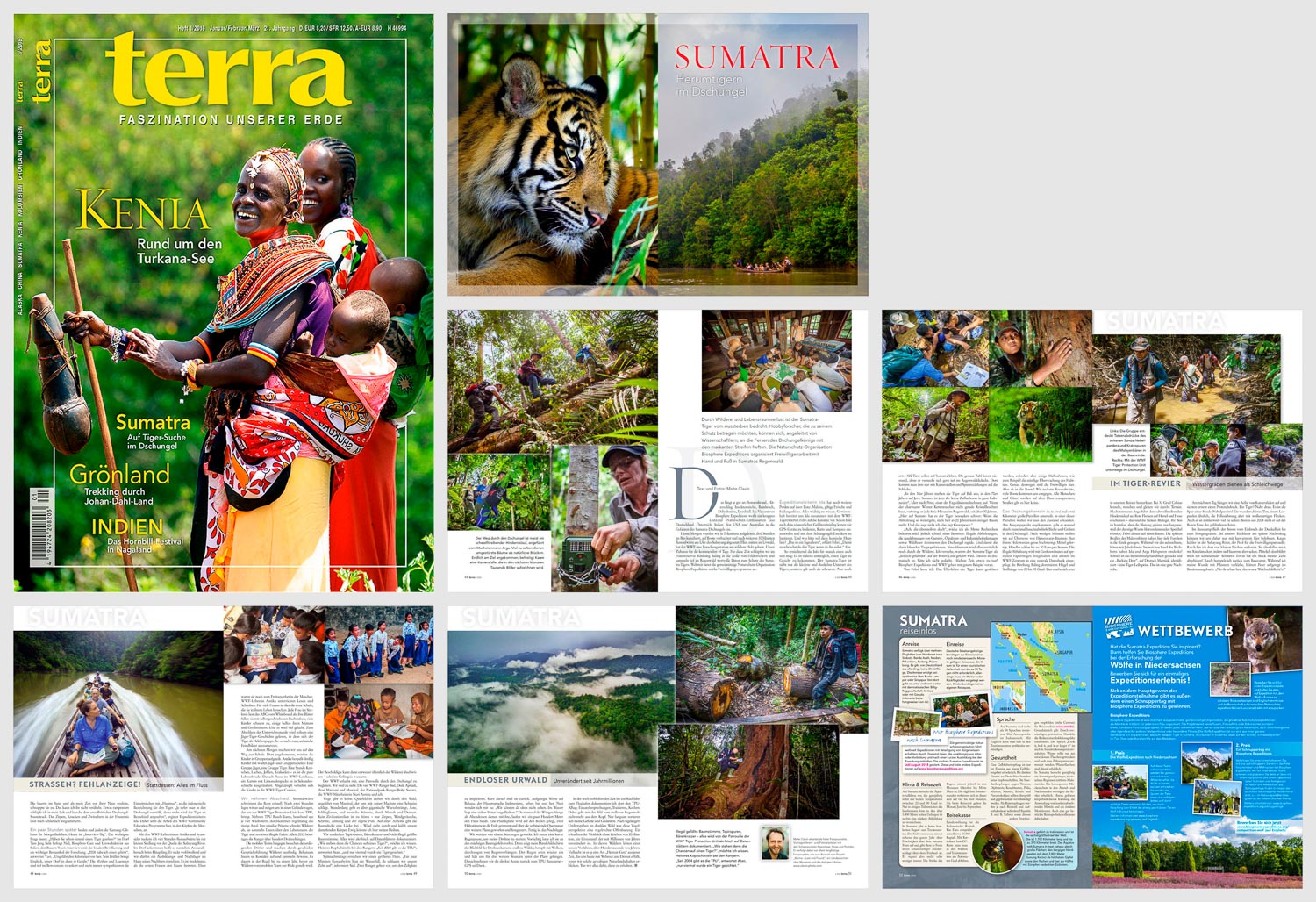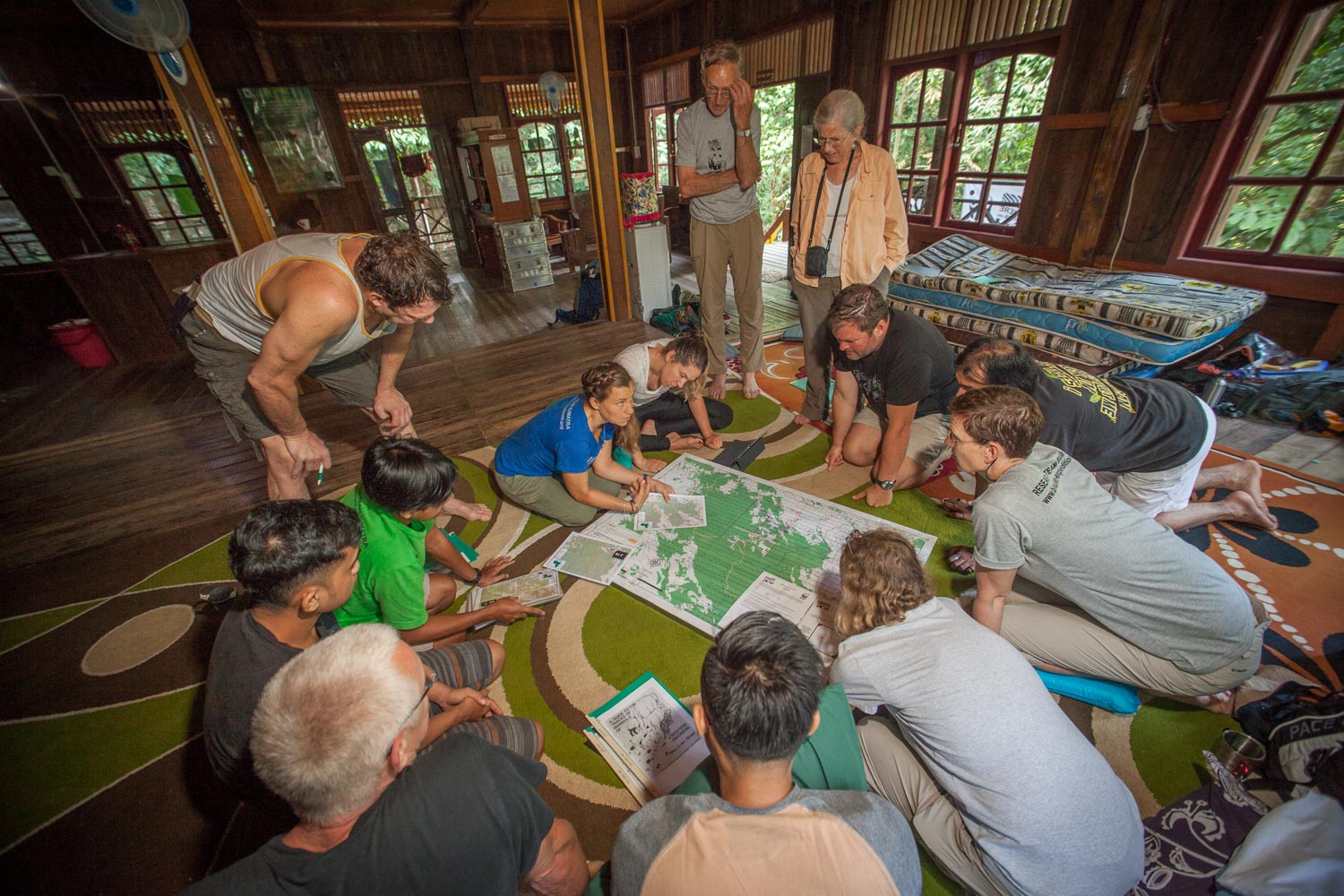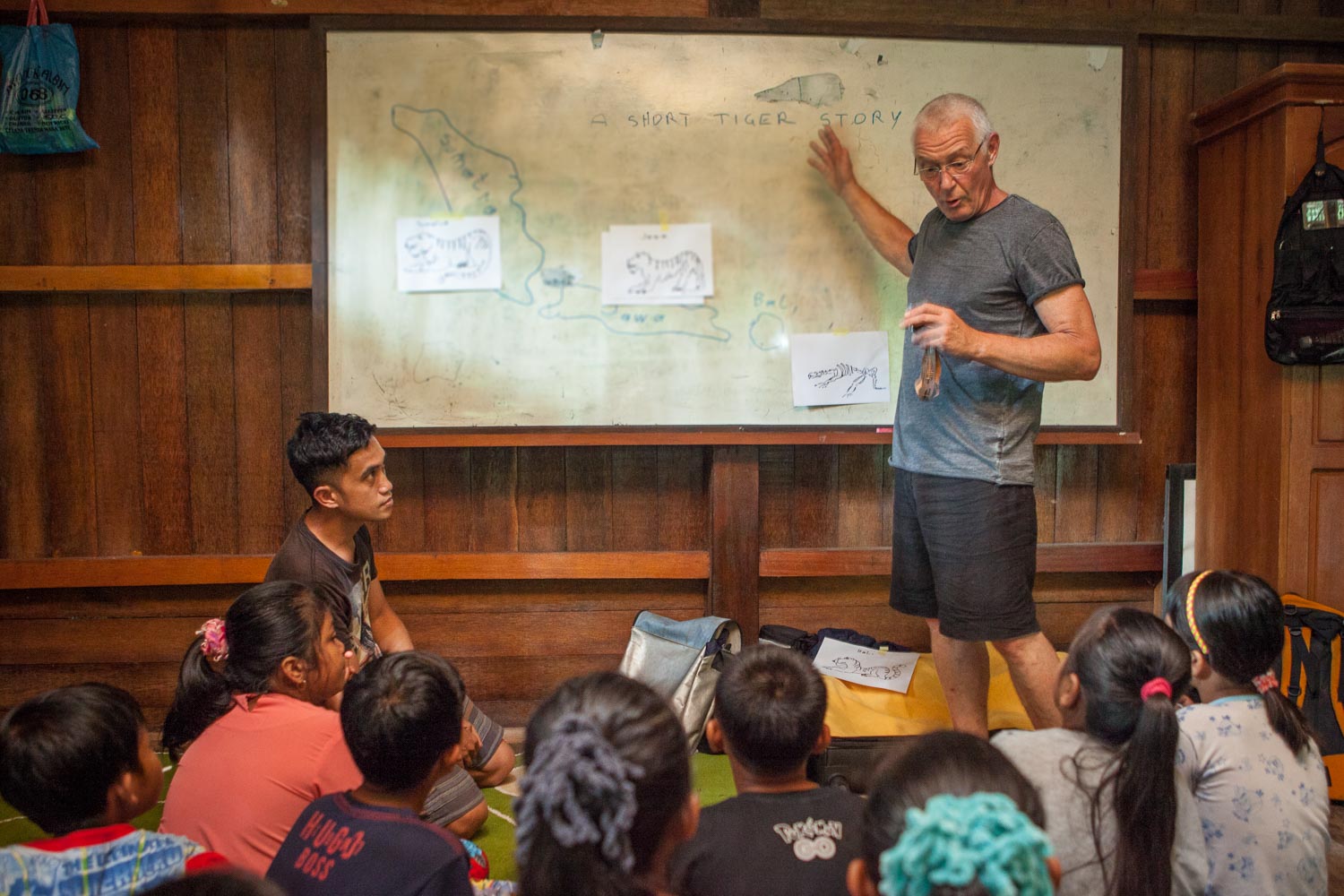Published in:

Germany’s biggest nature travel magazine
12 pages| text & photography
Roaming the jungle like a tiger
This morning we were picked up in Pekanbaru, driven for three hours by bus, transferred to boats and after another 30 minutes upstream we were dropped off on the banks of the Subayang. Here, in the middle of the jungle, the WWF has a research station made of sawn timber. Our home for the next 14 days.
During this period of time we assume the role of a field researcher in the Rimbang Baling Nature Reserve, and collect valuable data deep in the rainforest for the protection of the Sumatran tiger. The non-profit nature conservation organisation Biosphere has such volunteer programmes on offer worldwide.
Expedition leader Ida continues: malaria, poisonous frogs, snake bites. Meticulously she and WWF tiger expert Febri prepare for the missions. Soon after the horrific-hazards briefing, we learn how to use GPS devices, how to interpret map and compass and how to handle the snake venom extractor.
And excuse me, what about this weird horn here? “It’s a bugle,” Febri explains, “you use it to scare away the tiger when you see it.”Okay…
As much as some people would like to, it is almost impossible to spot a tiger. The Sumatran tiger is considered the shyest of all tiger species. It is the smallest and darkest. Only about 300 animals are said to still live on Sumatra. Nobody knows the exact number, as it prefers to hide deep in the rainforest bush. The only way to discover his whereabouts are camera traps and his numbers by counting marks.
“In the 30s the tigers died out on Bali, in the 70s on Java, Sumatra is now the last refuge in the whole of Indonesia.”It is Peter, one of the expedition members, who elucidates me.
When the charming Viennese chain smoker is not building crystal chandeliers, he spends every free minute of his time in the rainforest, for already over 30 years. “Here in Sumatra it has a particularly hard time: if deforestation continues like this, there won’t be a single tree left here in 20 years. And it is not me saying that, Greenpeace is.”
“You use it to scare away the tiger when you see it.”
“They must be exaggerating,” I repudiate. But research tells me otherwise: illegal logging, the enlarging of rubber, palm oil and industrial timber plantations and also the forest fires are rapidly decimating the jungle. And the animal populations in it. On top of that there is poaching.
I understand why the Sumatran tiger is classified as ‘critically endangered’ on the Red List. I couldn’t imagine it would be so dramatic. About time to do something about it! Biosphere and WWF are showing the way.
Febri teaches me: the survival of tigers can be safeguarded, but we need to take action. Like: continual monitoring of their habitat. That’s precisely what the volunteers have come for. So off we go into the boats!
But before that, I have to extract an impressive spider from out of my shoe. Caution is required! Sometimes scorpions can get in there too, and their bite is clearly a lot less pleasant. We chug upstream, many boats coming downstream towards us. All people and goods are transported on the river, there are no roads here.
The jungle terrain is divided into 2×2 km lots. On one of these lots we now want to check out the situation. After having arrived at the point of departure, we start wading through streams and trenches into the jungle, water sometimes up to the naval.
After a few minutes, we come across the remains of dipterocarp trees: their wood is often used to make high-quality furniture. Traders pay up to 30 Euros per trunk. The illegal felling is recorded with geo-coordinates on special paper sheets – and in the evening entered into a central database at the WWF centre.
Rimbang Baling is dominated by hills and steep slopes with a 20 to 90 degrees angle. We feel that in our legs now. In the 32 degrees centigrade heat we clamber, slide and glide through the terrain.
Machete-man Arga has the lead in the perspiration steeplechase. Red spots appear on shirt and trousers – these are the agile leeches. Their bite is harmless, but the blood only coagulates slowly as the thirsty worm uses blood-thinning saliva.
Febri points at a tree: the sharp claws of the Malayan bear drew deep furrows in the bark here. As we record this, we hear whoops: Ida and Arga have discovered hoof prints in the soft sand of the streambed! They quickly pull out their determination handbook and identify a ‘Barking Deer’, a tiger’s favourite food. That is good news.
Expedition leader (blue T-shirt) Ida briefing the Biosphere volunteer team for the day.
The other day we set up a series of camera traps and again spot a paw print. A tiger? Close enough. It is the track of a Sunda clouded leopard! A beautiful animal, similar to a leopard, only its fur has a cloud-like pattern. And is far too rare: it has never been off the red list of endangered species since 2008.
At Base camp there is electricity from dusk to dawn, so we have lukewarm beer only to reward ourselves. The Subayang River, the pool for the volunteer patrol, is hardly any cooler. I am quickly surrounded by small fish. They ambush me with tickle attacks, scraping off fragments of skin.
Suddenly I feel a stinging pain: something is biting off a piece of my toe! I quickly limp back to the base camp. While putting plasters on my wound, Peter excitedly leafs through the determination handbook: “No da schau hea, das woa a Weichschildkrötn! “. It was lurking in the sand and when my toe wiggled in front of its nose, it snapped. I can’t blame it.
“Its roar brings bad luck, our village is imperilled then.”
A little battered, I slip into my tent and listen to the perpetual jungle soundtrack. The chirping, cracking and twittering in the darkness finally lulls me to sleep.
At dawn, a few hours later, the Siamang gibbons howl and whine their morning tune. Today is ‘interview day’. “Have you ever seen a tiger?” In the village of Tam Jung Belit, Neil, Biosphere guest and environmental activist from Italy, interviews the farmer Yusri.
Interviews with local people are an important part of the research. “In 2008 I heard one. “replies Yuri, “Three kilometres from here. Its roar brings bad luck, our village is imperilled then.”
The myths and legends run deep and locals don’t always sympathise with ‘Harimau’ – the Indonesian name for tiger. “The deeper you go into the jungle, the more the tiger is seen as enemy and prey,” adds expedition leader Ida.
This is where the work of the WWF Community Education Programme comes in.
With the WWF teachers Antika and Syamsidar, I navigate four hours upstream to the last hamlet before the source of the Subayang River. On board: two rafts men who, every few minutes, heave the boat over the river’s shallows with long sturdy sticks. A back-breaking job.
After having arrived in the village, the first thing we do is pay a courtesy call to the chieftain. He nods favourably – and we are allowed to set up a training and night camp in his neighbour’s house.
It is pitch dark when the first women enter the room. They have just returned from Friday prayers at the mosque. WWF teacher Antika teaches reading and writing. For many women, this is the first school they have ever attended in their lives. Every woman sitting in the circle reads the ABC off the whiteboard, their sheets of paper are full of characters which they have penned down themselves, many children are onlookers, some aid their mothers and grandmothers. And there is a lot of laughter.
At the end of class, in turn, a hunter-tiger story is read in which the tiger turns out to be the hero. This is how archaic perceived enmities are eradicated.
During a refreshing bath in the river, an animal lurks buried in the bottom. And snaps. Soft-shelled turtles have sharp beaks and are carnivores. It looks worse than it is: with a bandage I can continue walking.
The next morning we set off for school. Once there, the children are divided into groups. Antika entertains thirty children with wild hunting and group games: one group – hunters, one group – tigers. An hour of shrieking, laughing, jeering, yelping – it’s pure joie de vivre.
Then it is time for a break in the WWF library, a box with lemonade cartons is emptied in seconds. Exhausted, the children delve into WWF tiger comics.
We say goodbye. Downstream, the boat coasts fast. After two hours we moor and change into an off-road vehicle that transports us to the WWF Tiger Protection Unit, TPU for short.
It is raining incessantly, for hours. We turn off the main road and pick up Jon Hendra, the head of the TPU is soaked. “Only another 26 kilometres of mud track!” he addresses us with a chuckle. Night falls. The jeep whines, bumps us around, we keep slowing down. Suddenly we come to a standstill. There is only the whinnying of spinning tyres. The smell of burnt rubber enters our nostrils.
“Only another 26 kilometres of mud track!” he addresses us with a chuckle.
Sweat beads on the driver’s forehead. “Pah,” Hendra shouts, “then we’ll just push”. The pushing team inches the car forward with strong determination, for a quarter of an hour, then the mud pit is cleared. Off to a good start, crosses my mind. Only shortly before midnight we reach the TPU.
Several TPU bush teams, each consisting of four rangers, constantly comb the huge area. Their constant presence deters poachers, they collect data on the tigers’ habitat and destroy illegal traps. In 2015 alone, the rangers removed over 100 wire snares.
The mobile teams, at the same time, visit surrounding villages and use their conversational skills to track down poachers. They painstakingly build up contacts and collect evidence. It can take up to a year before a poacher is confronted by the mobile team. The accused is given the opportunity then to publicly renounce poaching. Or go to prison.
At WWF headquarters, Peter teaches schoolchildren about the plight of the Sumatran tiger. The neighbouring islands of Java and Bali once had their own tiger subspecies. The Java tiger has been considered extinct since 2003, the Bali tiger since the early 1940s.
The WWF allows me to accompany a patrol into the jungle. There are seven of us: the four rangers Siid, Dede Apriadi, Atan Marzuni and Masrizal, the national park ranger Boby Sunata and the WWF staff member Nuri Asmita.
The next morning we set off. There are no paths, we walk cross-country through the forest, led by Masrizal, who cuts a path for us with his machete. For hours, only gigantic root strands, branches, creepers, mud, rotten tree trunks, thorns – eyes glued to my hands and feet. Gripping, holding, sliding, braking with my behinds – I am happy I was able to train with Biosphere for a few days beforehand.
No sound of civilisation is audible – only chirping, sounds of the wind, footsteps, breathing and my own pulse. On a hillock, the canopy opens up – a gentle breeze cools our sweat glistening bodies. I could stand here forever.
We discover tapir tracks, bear scratches and many tree trunks from illegally felled trees. Meticulously everything is recorded on data sheets. “What are the chances of spotting a tiger?” I want to know. With a smile the rangers shake their heads. “The TPU has been around since 2004”, Atan replies, “And only four times has a tiger been sighted. “
Late in the afternoon we reach a larger stream, “Just a few minutes upstream is a waterfall, we’ll pitch our tents there”. Siid tells us. Two rangers go up ahead to inspect the campsite. After a few minutes they are back. Animated talk in Bahasa, the main language of Indonesia, goes back and forth. Nuri turns to me: “We can’t camp up there. There is a 7-metre python in the water.”
„We can’t camp up there. There is a 7-metre python in the water.“
Since no one wants to end up as the constrictor‘s dinner, we walk a few hundred metres further down along the river. A plastic tarp is spread on the ground, two wooden logs are driven into the earth and another tarp is thrown over the connecting crossbar and tethered up. The night’s camp is ready.
We are woken up by torrential rain. A short lull in the downpour gives me a shot at launching my drone. Prudently I pilot it past the mighty tree tops. Then on my mobile phone screen appears the view from the drone‘s camera: endless forests, dabbed with clouds, streaks of precipitation.
The rain begins to fall again and keeps us confined under the tarp for another three hours. Then we take the direct route back to TPU Base camp – the GPS makes it possible.
For the remainder of the time until the journey back to the airport, I document the TPU’s daily routine: briefings, training, cooking.
I can’t get the image of the endless rainforest out of my head.
Only by and by do my feelings and thoughts arrange themselves. After days of roaming around in the dark forest, that bird’s-eye view revealed a completely different perspective: an illumined expanse – without signs of civilisation, a primordial state – unchanged for millions of years. Our ancestors lived in these forests – for hundreds of thousands of years.
Perhaps it is a kind of ancient-origin-gene from that past that fills us with a deep yearning and humbleness today, when we behold such stupendous natural landscapes. Let us do everything we can to preserve them.
Read now:
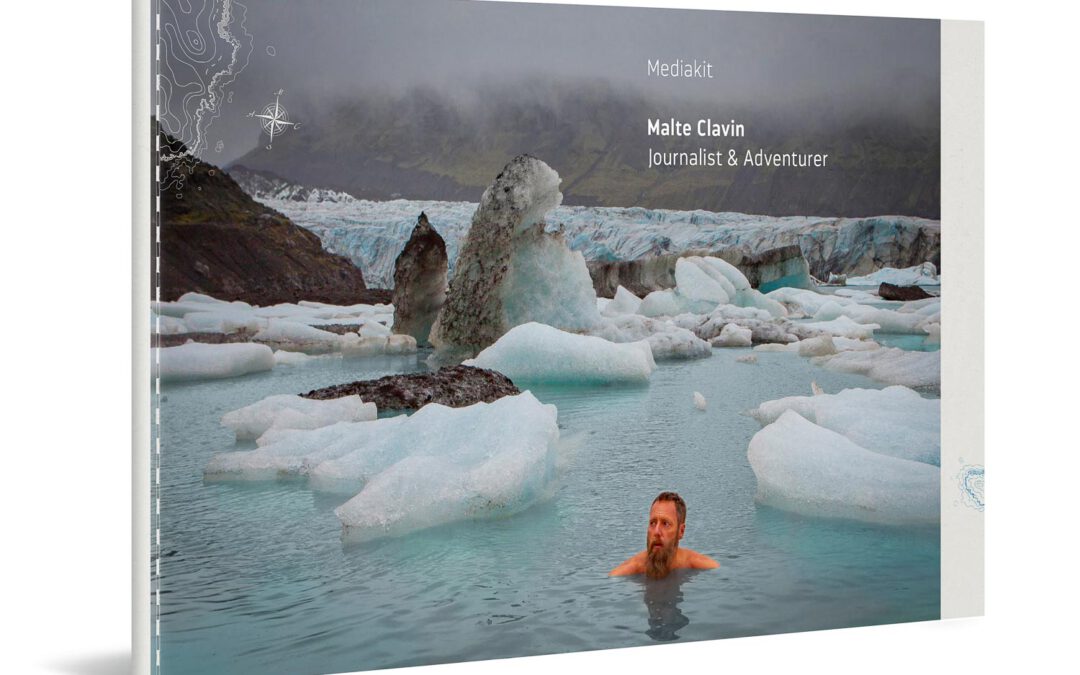
Pure inspiration
My new media kit 2025
< 1 Min.In this brand new 28-page media kit, I show you my work as an adventure journalist and speaker: Expeditions, travels, challenges – everything that excites me. Let yourself be inspired.
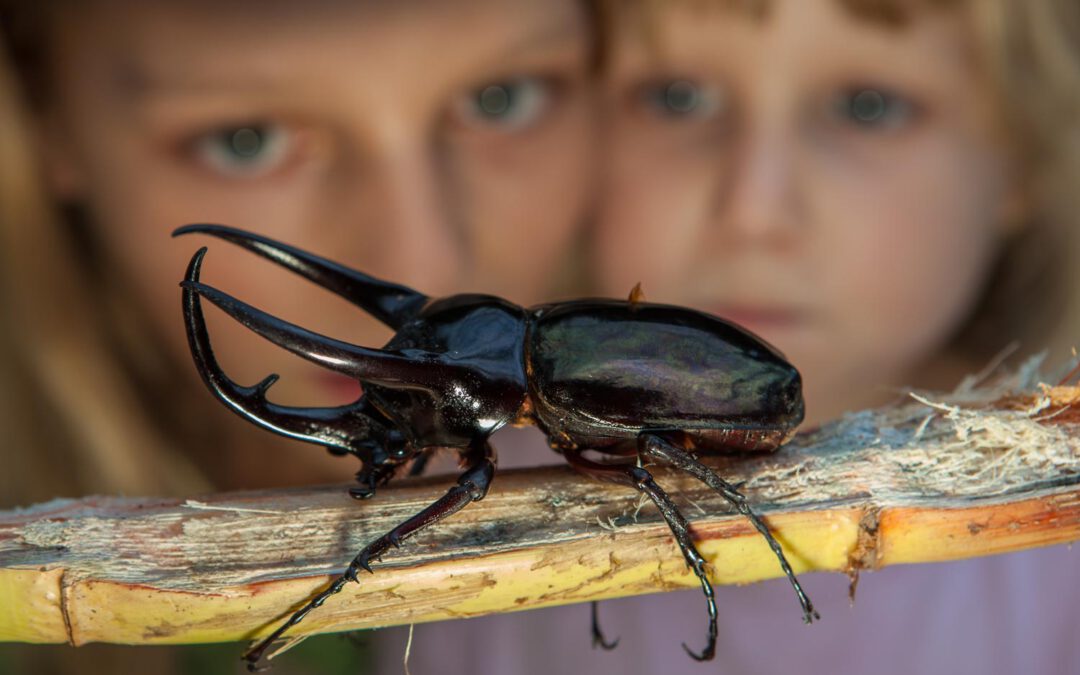
Publication in the Globetrotter-Magazine
Borneo – family adventure in the jungle
21 Min.Together with my wife Annette and our daughters Amelie and Smilla, we are looking for big adventures and discoveries off the beaten track on Borneo. And indeed, for weeks we can hardly stop being amazed.
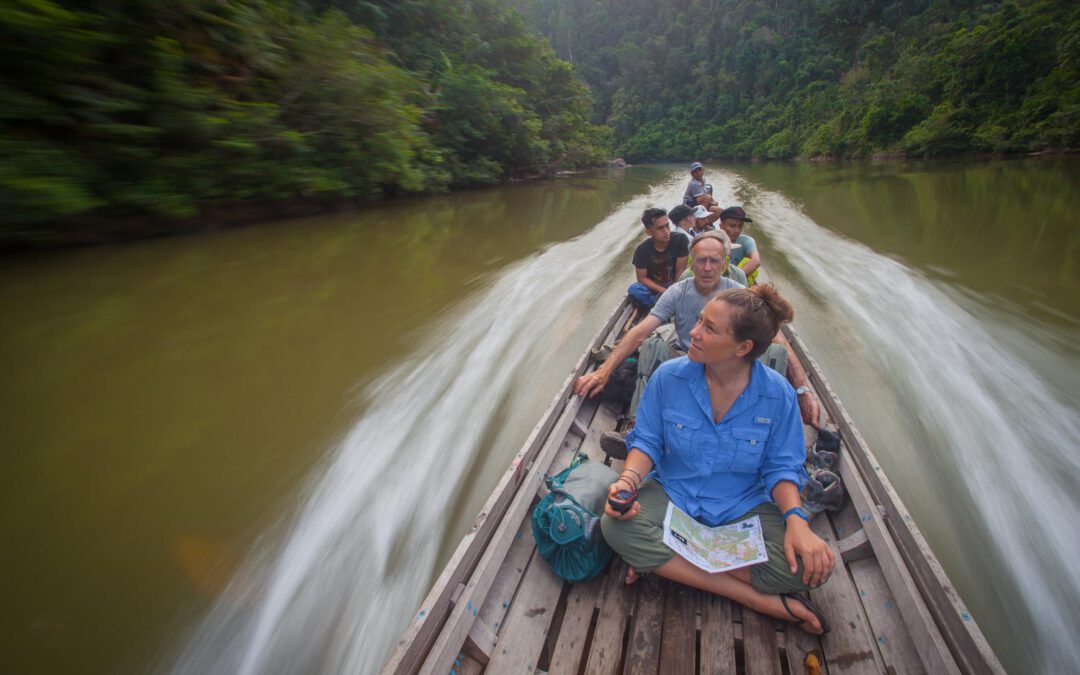
On the trail of the tiger
Sumatra photo gallery
< 1 Min.Images from my Sumatra expedition with WWF’s Tiger Conservation Patrol and Biosphere Expeditions.

